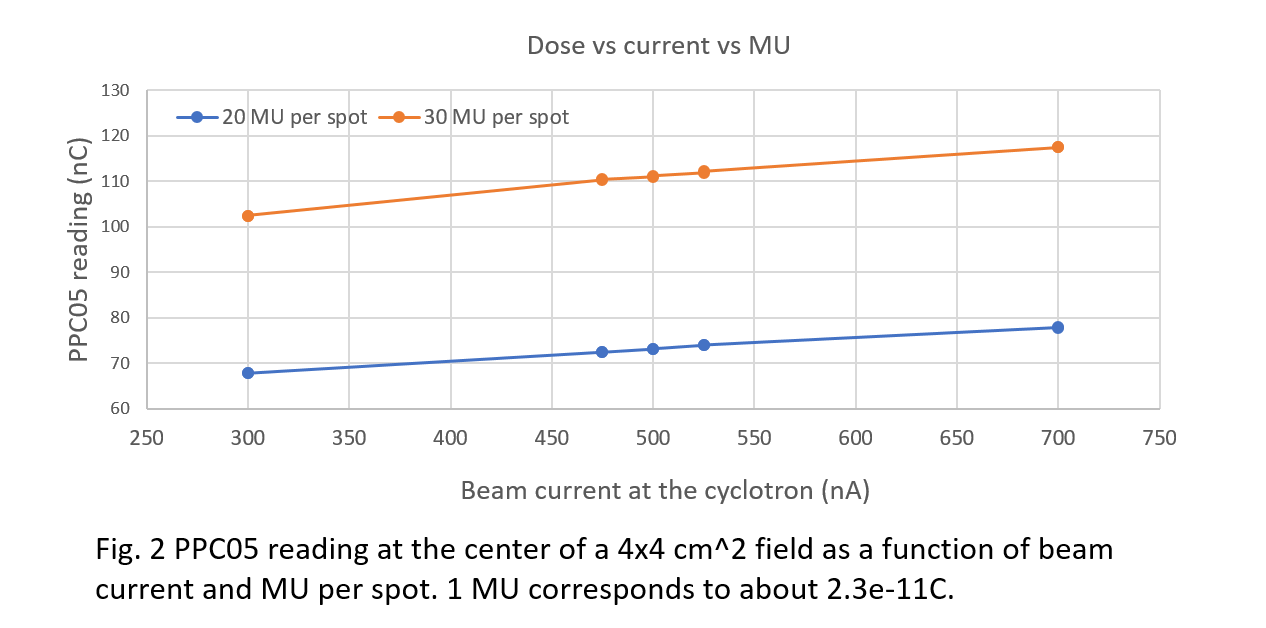Characterization of a ultra-high dose rate proton beam for preclinical experiments.
PO-1838
Abstract
Characterization of a ultra-high dose rate proton beam for preclinical experiments.
Authors: Marco Schwarz1, Jatinder Saini1, Francois Vander Stappen2, Leland Palmer3, Jing Zeng1
1Fred Hutchinson Cancer Center, Radiation Oncology, Seattle, USA; 2IBA, Proton Therapy, Louvain La Neuve, Belgium; 3IBA, Proton therapy, Seattle, USA
Show Affiliations
Hide Affiliations
Purpose or Objective
As a first step towards implementing ultra-high dose rate (UHDR) proton therapy treatments, we characterized a proton beam for pre-clinical UHDR experiments on a pencil beam scanning beamline used in clinical practice.
Material and Methods
After modifications to the beamline were applied to our gantry proton room (Proteus Plus, IBA Proton therapy, Belgium) to maximize the beam current at the isocenter, we characterized the UHDR beam in terms of:
a) Spot and shape in three configurations; pristine beam, 75 mm water-equivalent-thickness (WET) range shifter (RS), and custom-built 135 mm WET RS to be mounted 310 mm upstream of aperture in the snout housing.
b) Beam transport efficiency and beam output;
c) Dose homogeneity, beam penumbra, and dose rate for the fields to be used in pre-clinical irradiations.
All measurements were performed at isocenter, either in air or at 1 cm depth, and using the highest energy, corresponding to a nominal range of 32.9 cm in water.
Results
The range measurements acquired with a multi-layer ionization chamber are consistent within 1 mm with the nominal range.
In UHDR mode, the spot sigma at the isocenter ranges from 4.5 mm for the pristine beam to 9.2 mm for the 135 mm RS. The same energy is associated with a 2.9 mm sigma in clinical mode. The spot is constant for beam intensities ranging from 300 nA to 700 nA at the cyclotron. The results are summarized in figure 1.

The beam transport efficiency measured with a Faraday cup was about 80%, enabling >500 nA at the isocenter in UHDR mode. By comparison, the clinical beam optic has an efficiency of ~ 8%.
The beam output was measured with a plane parallel ionization chamber (IC) (PPC05, IBA dosimetry). (Both literature data and onsite comparisons with a Faraday cup indicated no significant recombination effects)
The IC measurements showed a non-linear MU vs. dose relation for varying beam currents, likely due to recombination effects in the IC of the nozzle beam monitoring system. For the same MU, the dose changed by ~ 15% when the current was increased from 300 nA to 700 nA at the cyclo. Small variations in beam current (< 5%) are associated with negligible dose variations (<1%), and the dose values are consistent given the same beam current and MU (range of variations < 1%). The results for the beam output are summarized in figure 2.

For preclinical irradiations, two field sizes were defined (4x4 cm^2 and 1.5x6 cm^2); both have a 135 mm RS to increase the spot and maximize the field dose rate, and use an aperture downstream of RS to sharpen the lateral penumbra.
For both fields, a combination of beam current, spot positions, and MU per spot was found that ensures an adequate dose homogeneity and beam penumbra, a field dose rate of at least 70 Gy/s for the UHDR mode, and 1 Gy/s for the conventional mode, for a dose of 19 Gy RBE.
Conclusion
The initial characterization indicates that our system is adequate for UHDR proton preclinical irradiations.